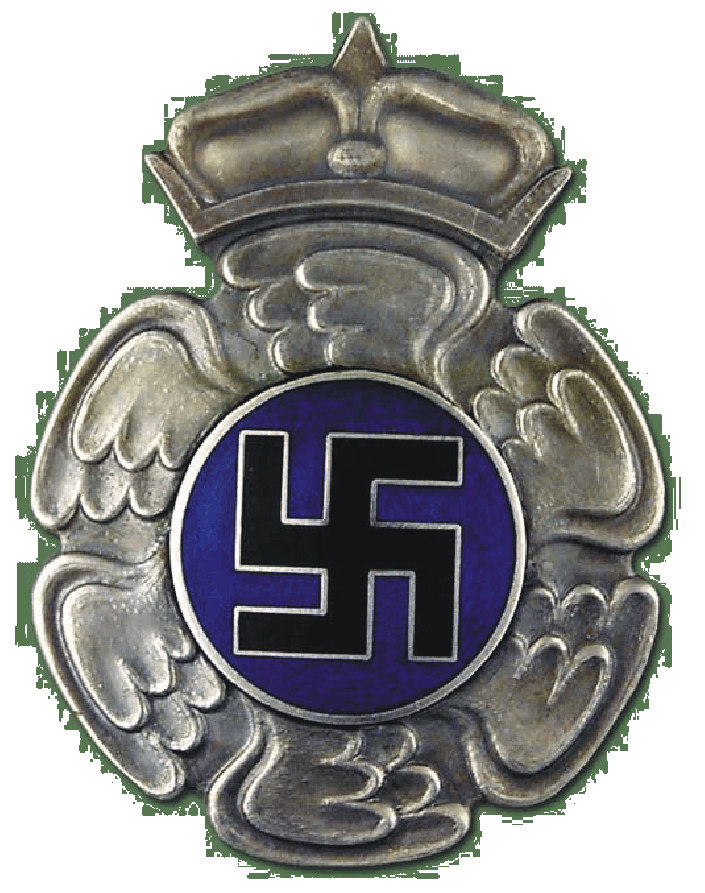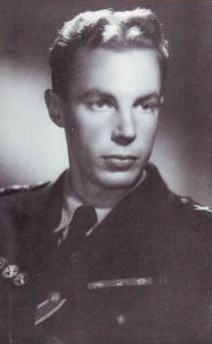Here
is a nice snap of Finnish Bf 109 G-2 "MT-213" of 2./LLv 34,
Suulajärvi airfield, May of 1944. Karhila'a "MT-229"
camuflage looks probably very similiar.
--------------------------------------------------------------------------------
It was the 20 August 1943. Lieutenant Kyosti
"Kossi" Karhila was another pilot of the 3rd flight of FAF
HLeLv 43 based in Kymi air base North of Kotka on the southern coast
of Gulf of Finland. The task of the flight was to defend the towns of
Kotka and Hamina, their harbour and the adjacent sea area with its military
objects against Soviet Air Force.
Four Bf 109 G-2 fighters were airworthy that
day at 14:41 hours as there was an alert: Four enemy Il-2M's escorted
by eight fighters approaching Someri island, situated 50 km South from
the base. Finnish pilots hurried to their fighters: Flight Commander
Captain Puhakka , his wingman Sgt. Nuorala, Flight Master Tuominen and
Lt. Karhila .
Lt. Karhila climbed in the cramped cockpit of
the "MT-229" while two mechanics worked hard hand-cranking
the flywheel of the inertia starter. The pilot closed the hood and went
through the pre-start check list before starting the engine. When testing
the magnetos, the no.2 magneto made the engine drop 150 rpm. That was
a bad sign but Karhila did not care: he gave a sign to remove the chocks
. He prepared for takeoff after Flt.Mstr Tuominen, because the narrow
airstrip could take only one fighter at a time. He had to wait for one
minute so that the previous fighter's slipstream would disappear, worrying
about the possibility of his own engine overheating.
Now Karhila applied power so that the Messer
began to roll. He steered the fighter with brakes and aligned it with
the runway. Then he gently applied more power, and to be able to control
the huge torque of the three bladed prop he pulled the stick to keep
the tailwheel on the ground. The Me's weak spot was its undercarriage:
the weak stilt-like legs and narrow wheelbase made it accident-prone.
The pilot kept increasing power, all the time feeling with his feet
when the rudder would "bite".
As Karhila felt that the rudder was responding,
he eased the stick and allowed the tailplane rise. Now he gently applied
full power, because he was able to counter the torque with pedals. The
Daimler-Benz engine growled at its' characteristic low note, accompanied
by the falsetto whine of the supercharger. The fighter was now accelerating
on its main wheels, the propeller blade tips sweeping seven (!) centimeters
from the runway gravel. The pilot waited until the Bf had accumulated
enough speed. Then the powerful engine pulled the fighter off the ground
at a light pull of the stick.
This was a normal Bf 109 take off. Any Meesserschmitt
pilot had to be able to do all this juggling without thinking about
it. (Not everyone made it: one FAF pilot, whose name better be withheld,
smashed five Bf's at start before he was rejected from training...)
When airborne, Karhila pulled in the undercarriage, landing flaps and
radiator gills. Next he adjusted power and set the prop pitch control
to automatic. Then he eased the seat belt across his chest to be better
able to look in the rear sector. His guns were loaded and the Revi gunsight
illumination was on. Lieutenant Karhila and "MT-229" were
ready and willing to fight the enemy. The pilot could not tell whether
he was a part of his aircraft or whether the fighter was a part of him...
Karhila followed Cpt. Puhakka in 3000 m. They
were not really flying in a finger-of-four formation as they should
have and they were trained to do. Karhila and Tuominen were experienced
and self-confident pilots who were hungry for more victories and unwilling
to fly as anybody's wing men.
The enemy turned back before attacking having
seen the four Me's, but the Finnish fighters pursued them and caught
up with the enemy formation over the Gulf of Finland west of Seiskari
Island (note: the Finnish names of those islands). Karhila saw the Flight
Commander attack two enemy fighters. He looked around and there, below
him he saw four "Sturmoviks" and six La-5 and Yak-7 fighters
flying South.
Karhila was just about to attack them as his
instinct told him to look back. There, 20 meters from his tail he saw
the nose of a La-5 with big white prop spinner shining in sunlight.
Without thinking the Finnish pilot slammed the stick to the right and
kicked the right pedal. He heard a crack in the left wing of the Me,
but the rest of the enemy salvo missed his fighter with the sound of
a passing express train, tracers flying. Karhila allowed his Messer
do two rapid turns in flat roll, contrails extending from the wingtips.
Where did the La appear ? He continued in a 30 to 45 degree dive to
NW with full power and "squirmed". He had checked the rear
sector some seconds before. When tightening his curve the Finnish pilot
saw the Lavotchkin 50 m behind his tail, looking menacing. The enemy
must have dived from the sun.
Karhila kept diving with full power, but he was
unable to shake off the enemy. For a second he was at a loss what to
do, but then he decided that attack would be the best defence. He had
to turn the nose of his fighter at the enemy at any means. Karhila pulled
the stick as hard as he could, steering his fighter in a climbing left
curve.
He curved tighter and tighter, increasing his
rate of climb at the same time. He saw that the enemy was losing on
him, but at the same moment he felt how his Me was about to stall. He
eased the stick and barely recovered the fighter from complete stall.
As the Bf 109 returned to full control, he was flying horizontally.
The La-5 was on the same altitude, on the opposite side of their common
turning circle.
Now Karhila curved tight again and soon he had
the enemy in his gunsight. He fired for the first time at 150 m. The
La-5 half-rolled and dived, the Finnish pilot followed. The enemy pulled
out of the dive, Karhila aimed and fired again at a range of 200 m.
The La-5 made another half-roll and dive, striving for the AA cover
of a Soviet base on Peninsaari Island. The enemy was now 800 m ahead
of him but Karhila was catching up fast.
When Karhila was within range and fired at 300
m, the enemy apparently decided to use the same manouver that had saved
Karhila: the La-5 pulled into a tight left climbing curve. The Finnish
pilot allowed the enemy turn for a second before following. The Me was
more manouverable than the LA-5, he approached the enemy fast.
At the range of 75 m Karhila aimed with rough
deflection and opened fire, shooting brief salvoes. The enemy fighter
took hits in its fuselage. When the range was 50 m, the La-5 broke in
two just behind the cockpit. Karhila's Messer was for a moment surrounded
by flying debris.
The tailless La-5 rocked violently, then nosedived.
More debris fell off, then the enemy pilot bailed out. Soon his parachute
opened and the pilote splashed in the sea. Karhila watched with fascination
how the tail end of the enemy fighter slowly fell, the rudder flipping
and showing the red star on both sides of the tailplane. Then he realised
what really happened and he shouted in the radio: "Anybody saw
- I shot a La-5!". It was his victory no. 18.
A Bf 109 fighter passed overhead - it was Oippa
Tuominen who responded and congratulated. Karhila saw a white streak
on the sea: a Soviet speedboat arrived to rescue the La-5 pilot from
his cold bath.
Now the "MT-229" engine began to act
up, making the fighter vibrate violently every now and then. Also there
was a big hole in the left wing. It certainly had been a close shave,
and Karhila took course to the base with low power, anxious to avoid
any more fighting this time.
He made a victory pass over the base before landing.
Landing a Bf 109 was nearly as tricky as taking off. The pilot had to
control the attitude of the fighter so that the nose would not be too
down - the prop would literally "bite dust" - nor should the
plane be allowed to stall at low altitude and smash the flimsy undercarriage
legs.
But Karhila landed expertly. He parked the "MT-229"
and climbed out of the cockpit. The ground crew already had heard the
good news, they also could see that soot from the muzzle flashes of
the guns had soiled the nose of the fighter and the pilot was drenched
in sweat and his knees appeared to be a bit weak. There also was a gaping
hole in the left wing...
Everybody congratulated Karhila for his victory.
To "bag" a La-5, a very dangerous opponent, after being surprised
by it proved excellent flying skill. What Kossi Karhila had experienced
was the nightmare of any fighter pilot - but he had been able to "turn
the tables" and survived . You could not find a happier man in
Kymi air base that day.
He had been lucky, too, because the mechanics
told that the enemy hit had virtually split the main spar of the wing
and it had been a miracle that the damaged wing had withstood the stress
of the battle and the victory pass. The wing had to be replaced before
"MT-229" was airworthy again. The other pilots had not been
very lucky: Capt Puhakka's guns had jammed and Flt.Mstr. Tuominen could
not prove that he had shot down one Boston bomber.
Kyosti Keijo Ensio Karhila was born on 2 May
1921 in Rauma. In 304 battle missions he scored 32 1/4 victories. His
civilian job after war was an airliner pilot. Currently retired.
More exciting details from Karhila career please
check in his most interesting interview, exclusive for WW2AS!



